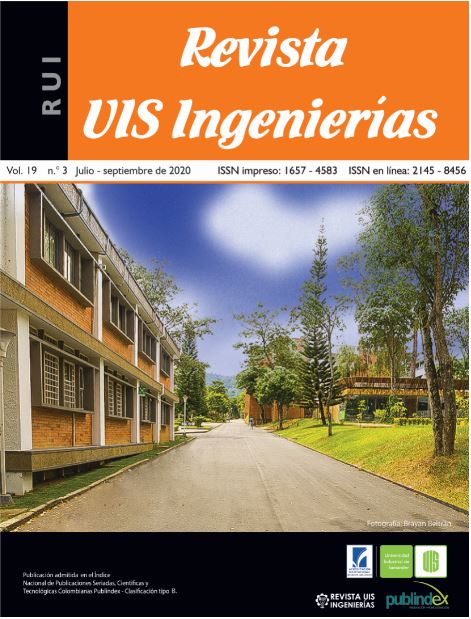Assembly and instrumentation of a didactic bench for testing of starters of internal combustion engines
Published 2020-04-29
Keywords
- engine starter,
- test bench,
- starter performance characteristics,
- flywheel,
- instantaneous speed
- voltage,
- current ...More
How to Cite
Copyright (c) 2020 Revista UIS Ingenierías

This work is licensed under a Creative Commons Attribution-NoDerivatives 4.0 International License.
Abstract
The instantaneous measurement of angular speed in flywheels has been used, among other applications, in experimental tests of internal combustion engines to diagnose their working conditions; particularly it has been implemented to evaluate the performance curves of starter motors and the battery conditions. This article focuses on the development of a flywheel-based didactic test bench to diagnose performance of starters of up to 3 kW power, installed in internal combustion engines of up to 3 liters of displacement, typical of commercial cars. The main features of the designed bench are described: mechanical elements, structural elements and accessories; angular displacement, current and starting voltage sensors and systems for reading, processing and presentation of information. An inductive sensor is used for the detection of the angular position of a flywheel equipped with a toothed crown; the analog signal is converted to digital and digitally processed in a code written in Matlab®. During the test of the testing starter motor, the variation of the electric power delivered by it and the variation of the angular speed of the charging system (flywheel) from its initial state to stabilization are determined. The acquired experimental information is used to construct and analyze the behavior profiles of instantaneous angular speed, current intensity, voltage and electrical power. Confronting the forms of characteristics of commercial starters provided by the starter manufacturers, with those of the voltage, current and consumed power signals of the starter tested in the built bench, allows us to conclude on the suitability of the designed test bench and the conceived methodology to carry out didactic characterization and diagnosis tests of starter motors in the Laboratory of Internal Combustion Engines of the Technological University of Pereira.
Downloads
References
[1] Romero, Carlos Alberto. Fundamentos teóricos de la construcción de máquinas de combustión interna (sistema de arranque de los motores). Pereira, Risaralda, Colombia. Universidad Tecnológica de Pereira. 1995.
[2] Vinogradov Jan, Averbukh Moshe and Rivin Boris. “On Board Battery Condition Diagnostics Based on Mathematical Modeling of an Engine Starting System”. SAE Technical Paper 2007-01-1476, 2007.
[3] Murugesan V, Chandramohan G, Kumar Senthil, Kumar Suresh, Murthy Vishnu. An overview of automobile starting system faults and fault diagnosis methods. Coimbatore, India. ARPN Journal of Engineering and Applied Sciences. July, 2012.
[4] Nyberg Mattias. Model based fault diagnosis, methods, theory, and automotive engine applications. Sweden. Linköping University. Department of electrical engineering. 1999.
[5] Perez, J. M Alonso. Estudio del motor de arranque. [auto. libro] Alonso Pérez. Electricidad del Automóvil. Madrid: Paraninfo.
[6] Cantuña Flores, Julio Gabriel; Cerón Dorado, Marco Geovanny. Diseño y construcción de un banco de pruebas para motores de arranque. Repositorio digital ESPE. [En línea] abril de 2006. http://repositorio.espe.edu.ec/bitstream/21000/4002/1/T-ESPEL-0252.pdf.
[7] Gambotti, Laurent. Oscaro. [En línea] Oscaro Recambios SL. [Citado el: 22 de octubre de 2013.] http://www.oscaro.es/rele-motor-de-arranque-bosch-0-331-402-001-40301-2188-p.
[8] Pérez, José Manuel Alonso. Técnicas del Automóvil. Madrid: Paraninfo, 1998.
[9] Crouse.W.H. Automobile Electrical Equipment,McGraw Hill Book Co
Inc.NewYork, 2005.
[10] Judge.A.W.Modern Electrical Equipment’s of Automobiles, Chapman & Hall, London 2004.
[11] Robert Bosch, Automotive Handbook, Bently Publishers,2004.
[12] Merchan Ramos Carlos Eduardo. Determinación de la Potencia y el Torque en Motores de Combustión Interna mediante la Técnica de la Aceleración Libre. Bucaramanga, Colombia. Trabajo de Grado, Universidad Industrial de Santander. Facultad de Ingenierías Fisico-Mecánicas.
[13] SKF. The SKF model for calculating the frictional moment [en línea]. Disponible en:< https://www.skf.com/binary/12-299767/0901d1968065e9e7-The-SKF-model-for-calculating-the-frictional-movement_tcm_12-299767.pdf>.
[14] Goldstein, S. “ On the resistance to the rotation of a disk immersed in a fluid,”. Proceedings of the Cambridge Philosophical Society, Vol.31, part II, Apr. 1935, pp. 232-241.
[15] Gupta, R.B. “Cold starting of IC Engines”. Indian Institute of Petroleum, Dehra Dun-248 005. Def Sci J, Vol 38, No.1, January 1988, pp 77-85.
[16] Viorel Ioan, Szabó Loránd, Löwenstein Lars, Stet Cristian. “ Integrated starter generators for automotive applications”. Technical University of Cluj-Romania, Department of Electrical Machines. Volume 45, Number 3, 2004.

